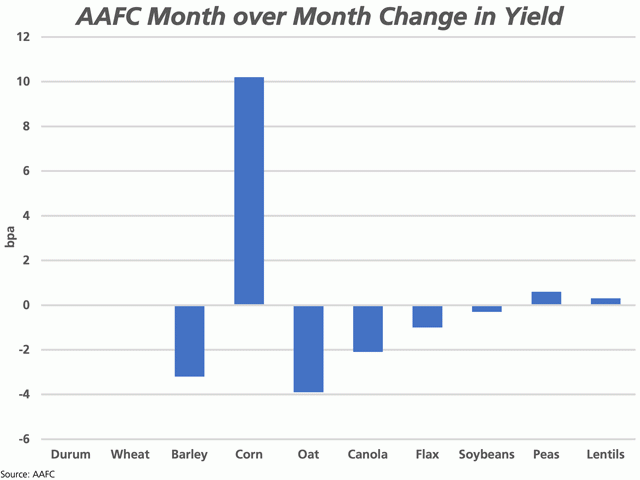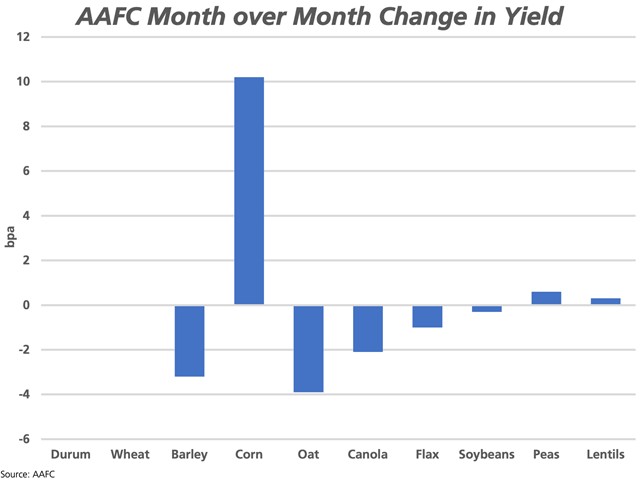Canada Markets
AAFC's July Estimates Postpone the Inevitable
Agriculture and Agri-Food Canada's (AAFC) Outlook for Principal Field Crops report for July, the last month of the 2020-21 crop year except for corn and soybeans, included seeded acre revisions based on Statistics Canada's acreage report on June 29.
This month's report also saw some changes to 2020-21 demand estimates, while ending stocks were left close to unchanged from last month. Wheat exports (excluding durum) were revised 50,000 metric tons (mt) lower to 21 million metric tons (mmt) for the current crop year, while domestic use was revised higher by the same volume to keep ending stocks unchanged at 4 mmt.
It is interesting to note that the durum export estimate was left unchanged from the previous month at 5.8 mmt, when this volume is almost already reached as of the CGC's week 49 statistics.
The largest change in demand was seen for barley, with 2020-21 exports revised by 200,000 mt higher to a record 4.5 mmt. Feed demand was revised lower by the same amount to keep stocks at a record low 500,000 mt. The current tightness in stocks has Lethbridge barley trading above $400/mt this week for the first time ever.
P[L1] D[0x0] M[300x250] OOP[F] ADUNIT[] T[]
The estimate for ending stocks for all of Canada's principal field crops rose by 35,000 mt this month to 8.870 mmt, reported as the lowest overall stocks in eight years and down 30.5% from 2019-20.
Ending stocks for all principal field crops are forecast to fall by a modest 140,000 mt by the end of 2021-22 to 9.730 mmt. To achieve this, production of Canada's principal field crops is forecast to fall by a modest 3.7%, while export demand is revised 12.4% or 7.325 mmt lower and domestic demand is forecast to fall by 1.9% or 945,000 mt.
As they say, it looks good on paper. But this month's forecast has missed the week-over-week deterioration in crops as reported by the three Prairie provinces. As seen on the attached chart, yield estimates for both wheat and durum were left unchanged this month from the estimates released in June. Over the past month, the canola yield was revised 2.1 bpa lower to 39.3 bpa, less than 1 bpa than the final yield estimated for 2019-20.
Dow Jones commentary on Wednesday pointed to AAFC's July forecast canola production for 2021 of 19.9 mmt as one of the bearish factors leading to the sharp sell-off in canola on July 21. While the November contract ended $29.20/mt lower Wednesday, it fell by as much as the $50/mt limit in morning trade. The report also pointed to showers in the eastern Prairies, a drop in soybean oil and a sharp rally in the Canadian dollar against the U.S. dollar as other bearish factors.
While no one knows how crop production will turn out this year, there is likely a long list of producers who would be willing to argue against the idea of a canola crop that is 1.2 mmt higher than realized in 2020. This is coming at a time when the Canadian Cattlemen magazine is circulating a piece on feeding drought-stressed canola as a forage for livestock.
Meanwhile, the first official estimates of Canadian yields will not be released until Aug. 30, based on July estimates, and then again on Sept. 14, based on the model-based approach using August data. By then, a significant area of the Prairies should be harvested, and this will be months after the USDA released their first official yield estimates.
In all fairness, AFCC states in written commentary that "downward pressure on yields is possible as drought persists in most of the Prairies," while the provinces have been telling us this for weeks on end and a great deal of the damage has already been done.
Cliff Jamieson can be reached at cliff.jamieson@dtn.com
Follow him on Twitter @Cliff Jamieson
(c) Copyright 2021 DTN, LLC. All rights reserved.






Comments
To comment, please Log In or Join our Community .